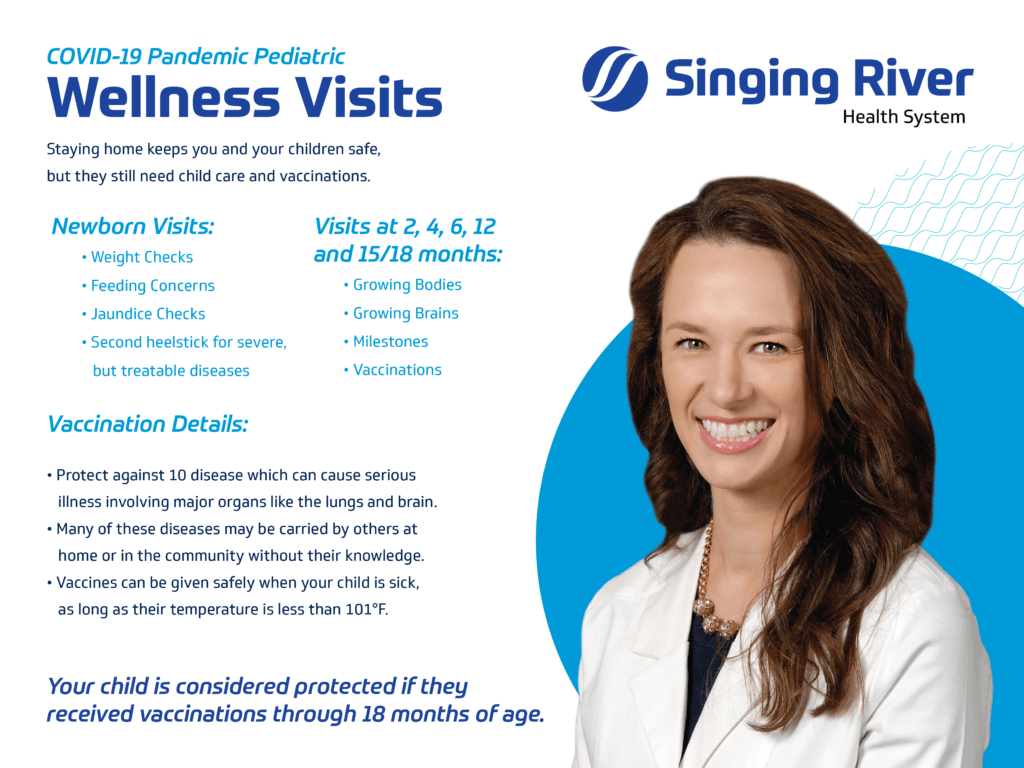School Re-Entry COVID-19 Guidelines
Singing River Health System is providing the following guidance, in accordance with the American Academy of Pediatrics and other leading medical organizations, in order to help our community create policies that will support and protect the health of individuals –both children and adults—as many prepare to return to school.
“The AAP strongly advocates that all policy considerations for the coming school year should start with a goal of having students physically present in school.”
General
- 3-6 feet of distance between desks/seating. While 6 feet is ideal, evidence shows that 3 feet allows for more students and similar benefits in youth-to-youth transmission risk reduction.
- 6 feet between adults. Adult–to-adult interactions should be spaced out a full 6 feet apart.
- Hand hygiene. Children and adults alike should wash hands or use hand sanitizer before and after eating, using shared equipment (i.e. computers, gym equipment, etc.), using the restroom, etc.
- Limited or virtual meetings for teachers/staff. Curriculum planning and other group meetings of adults should be limited or done virtually.
- Discouraged congregation of adults. Teachers, parents, and school staff should be discouraged from grouping in common areas, such as teachers’ lounges or breakrooms.
- Reduction of parent contact. Parents should be discouraged from coming into the school building, pick-up & drop-off times should be staggered, and plexiglass installed in reception areas.
- Spend time outdoors. When available, outdoor spaces are preferred
- Cohort groups. Grouping students into logical cohorts can assist in minimizing crossover among children and adults in a school setting. Cohort group sizes may vary based on needs and can be achieved in many ways.
- Assigned seating. Reduce crossover by assigning students desks in classrooms, common areas, and buses.
- Rotate teachers, not students. When students are traditionally asked to change classrooms, have teachers rotate instead, where feasible.
- Rework hallways. Consider creating one-way hallways, label floors with appropriate distances where crowding/lines may occur.
- Stagger schedules. In an effort to reduce crowding and crossover in hallways, if students must change classrooms, consider staggering class periods by cohort.
- Eliminate or group lockers. If the use of lockers cannot be feasibly eliminated, group locker assignments by cohort.
- Small groups/cohorts on playgrounds. Outdoor transmission of COVID-19 is much lower than indoors, so while physical distancing may be difficult to enforce on outdoor playgrounds, emphasis can be placed on limiting the number of students at any time and grouping students by cohort.
Meals
- Group by cohort. Consider keeping children grouped in cohorts in their classrooms for meals.
- Stagger lunch periods. Minimize the number of people in the cafeteria at any time with varied lunchtimes.
- Add new lunch spaces. Consider utilizing additional spaces for lunch/break times.
- Follow hand hygiene. Have everyone wash their hands or use hand sanitizer before and after eating.
Buses
- Encourage alternatives to bussing. When possible, parents should identify alternate means of travel to and from school for students.
- Symptom screening. Ideally, screening for COVID-19 symptoms would occur prior to boarding the bus, however, this may prove difficult if the bus driver is tasked with screening since the driver would be faced with a dilemma on what to do with a child who fails the screening, but whose parent has already departed.
- Assigned seating. Clearly designated assigned seats, grouped by cohort.
- Mask wearing. If children cannot be spaced 6 feet or more apart, cloth face coverings should be worn by students.
- Driver distancing. Consider installing a plexiglass barrier to separate the driver from the children, require the driver to wear a cloth face covering, and maintain a 6-foot distance between the driver and all riders.
- Minimize adults on the bus. Adults who do not need to be on the bus, should not be on the bus.
- Minimize the total number on the bus. When feasible, reduce the number of people on the bus at one time.
- Open the windows. If the weather permits, open the windows.
Cleaning & Dissinfecting
- Maintain good hand hygiene. No cleaning strategy is a replacement for responsible hand hygiene. Ensure students are washing hands appropriately to stop the main source of spread: person to person.
- Clean as usual – then disinfect. Normal cleaning protocols should be followed, as simple soap and water significantly reduces viral load and enhances the disinfection procedures that should follow.
- Disinfect appropriately. When available, use EPA-approved disinfectants for use against COVID-19 that contain active ingredients like ethanol, citric acid, or hydrogen peroxide, and ensure that the disinfectants are labeled as safe for humans and the environment.
- Disinfect after hours. Children should not be present during routine disinfection activities.
- Daily high-touch surface disinfection. Doorknobs, water fountains, sink handles/faucets, computer & gym equipment are just a few examples of high-touch surfaces that should be cleaned no less than once per day, but ideally as often as possible.
- Some surfaces do not need daily disinfection. Any indoor space or surface that has not been used for 7 or more days can be cleaned using standard cleaning procedures, as well as outdoor playground spaces.
Testing/Screening
- Symptom screening upon arrival? Many businesses and organizations are requiring temperature checks and symptoms screenings in an effort to keep symptomatic individuals out of their buildings. This may not be practical for many schools and should be weighed against the loss of active learning time for students. Consider implementing a method for parents to self-report temperature checks at home.
- Emphasize that sick individuals stay home. Parents should be instructed to keep their child at home if they are ill and any person with a fever of 100.4 degrees or symptoms of COVID-19 should not be present in the school.
Additional Considerations
- Students with Disabilities may require adjusted policies. In order to accommodate their varied needs, policies and requirements may need to be adjusted to fit the physical, mental, emotional, and developmental needs of students with disabilities.
- There is no “One Size Fits All.” Guidelines for COVID-19 school re-entry policies may vary by school type, student age, and school location/community viral transmission conditions and should be made with the guidance of local healthcare professionals and officials.
- Behavioral health resources will be in demand. Schools should anticipate increased stress and anxiety in student populations, as well as the need for staff training on how to communicate COVID-19 related policies and procedures in a way that does not increase these issues.
- Immunization requirements should NOT be altered. Existing policies for immunization should remain consistent and not be deferred as a result of COVID-19. Schools should encourage students to receive the flu vaccine, and consider requiring it for staff members.
It is important to keep in mind that our understanding of COVID-19 and its impacts are changing rapidly and these recommendations are in line with our most recent understanding of the pandemic and its effects and causes.

Providers
